Tomorrow: Advocacy Rally to Make Clairemont Safe for All Users; Today: Call Caltrans District Director
Since David Ortiz's death last year, neither the City of San Diego nor Caltrans have made any changes to fix the deadly intersection at Balboa Avenue by the on/off ramps leading up from the I-805. Ortiz was killed while trying to navigate the intersection while vehicles travelling at a much higher speed than him were merging onto his route.
We can't continue to live in a city where residents traveling at different speeds are unwittingly pitted against one another. Bicycling is something that is safe, healthy and fun and all San Diegans ought to be able to navigate the city on two wheels along a road network that should be designed for their safety and benefit. We have a two part advocacy strategy we need your help with which is the start of the process that will transform San Diego into one that is both safer and more pleasant to live in.
1. Today: call Caltrans District Director Laurie Berman at 619-688-6668 and ask her to please attend the City Council meeting tomorrow morning at 10AM and offer a verbal commitment that her agency will make a good faith effort to work with the City of San Diego to begin redesigning the city's deadly merges and intersections that unwittingly pit road users against one another. Caltrans has jurisdiction and ownership of the freeways in the city and they need to work with the city in redesigning the areas that lead up to the surface streets where our riders travel on two wheels. As an immediate first step, we would like Caltrans and/or the City of San Diego to mark these high speed merge areas as a construction zone with construction signs and orange construction barrels so that all road users can be appropriately cautious and drivers can slow down so that they won't unwittingly harm another San Diegan.
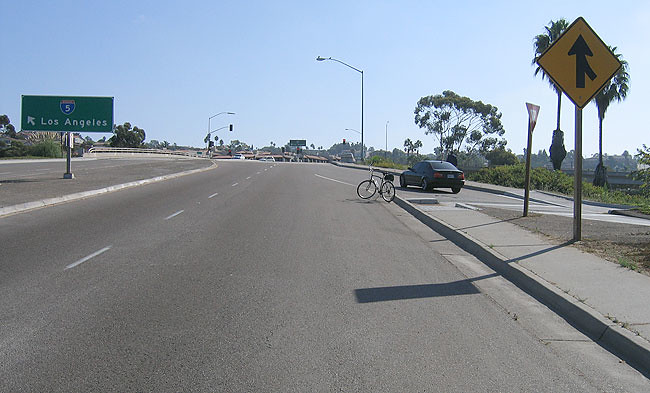
2. Attend tomorrow's City Council Session. Public comment is scheduled at the beginning of the session at 10 AM, and we intend to ask Councilwoman Lorie Zapf to recommend that the City of San Diego apply for the funds needed to fix these deadly interchanges, starting with her district. We would like Councilwoman Zapf to call on Caltrans and the City to work together and to begin work within this year so that Caltrans' Deputy Directive 64 actually has some teeth behind the current nice intention. In the mean time, we would like Councilwoman Zapf display her leadership of not only recommending long term substantive redesign solutions along Balboa Avenue and Clairemont Mesa Boulevard, but we also want her to recommend a quick fix of temporarily making the dangerous merges along these two roads a construction zone until they are fixed and made more inviting to the more vulnerable road users. If you are unable to attend the session tomorrow, please call or email Councilwoman Zapf's office to offer your support for our efforts to make Clairemont safer.
Making Clairemont More Livable: Fixing the Deadly Freeway Merges onto Surface Streets
In light of last Thursday's deadly collision, we wanted to highlight an effort we initiated last year with Councilwoman Lorie Zapf's office. We initiated this discussion because of another deadly collision that killed David Ortiz on Balboa Avenue. In the nearly 9 months since Ortiz's death, the City of San Diego has undertaken no effort to redesign the deadly intersections that litter Balboa Avenue.
Michael Sullivan,a resident of Clairemont, was identified as a resident who was willing to take an initiative to drive this discussion. The following writeup is by Sullivan.
----
Meeting with Lorie Zapf Staff re: Balboa and 805 interchange.
About a month ago, I was thrilled to get invited by Sam Ollinger to attend a meeting with representatives (Alex Bell and Kelly Batten) from Lorie Zapf’s staff. The purpose of the meeting was to voice concern about bike safety on Balboa Ave at the interchange with interstate 805. This is the overpass where David Ortiz was tragically killed while riding his bike to work. Since his death, the city has not made a single improvement to make the interchange safer for bikes.
I was invited to the meeting because I am a resident of Clairemont (part of Lorie Zapf’s district) who commutes to work by bicycle. I have ridden this stretch of Balboa several times and have a good understanding of the danger areas. I do not typically ride on Balboa though because of safety concerns. I prefer to ride several miles out of my way and up a steeper hill to avoid the dangerous high-speed merge areas on Balboa.
Before the meeting, I prepared a presentation about a possible solution for the Balboa / 805 interchange. I also prepared infrastructure improvement suggestions for all of Balboa from the 5 to the 805. Sam had also prepared a solution for the Balboa / 805 interchange and we presented them to Lorie’s staff. They were attentive and engaged and relayed that Lorie herself has expressed desire to improve bike-ability in Clairemont. We talked about how riding can be quite pleasant in the neighborhoods but that once you have to travel to any point outside of your neighborhood, bicycling becomes anything but a pleasant ride.
Sam presented a traffic calming solution that is being implemented at interchange areas in bike friendlier cities throughout the country. It removes the curved right turn on-ramps and off-ramps and replaces them with 90 degree turns. “90 degree-ing” the intersections forces traffic to slow down which greatly improves safety in the dangerous merge areas (see before and after images of the deadly intersection in Montreal that was redesigned). Implementation projects included a redesign from the City of Charlotte where the excess land after a redesign of some of the interchanges to be more urban in configuration was freed up for development.
 I presented a cycletrack solution that eliminates the dangerous merge areas altogether. My idea is to use the wide elevated median on the overpass and use it as a space for a cycletrack. This solution, while unproven, completely removes bicycles from the dangerous (some may say suicidal) merge areas. It is also something that could be quickly implemented throughout San Diego since almost all of these style overpass areas have huge elevated medians. It would also require minimal construction. The city would only need to add ADA style ramps at the beginning and end of the medians and also add bike signals to the intersections that are on either side of the interchanges. The signals would allow bikes to safely enter and exit the median cycletracks.
I presented a cycletrack solution that eliminates the dangerous merge areas altogether. My idea is to use the wide elevated median on the overpass and use it as a space for a cycletrack. This solution, while unproven, completely removes bicycles from the dangerous (some may say suicidal) merge areas. It is also something that could be quickly implemented throughout San Diego since almost all of these style overpass areas have huge elevated medians. It would also require minimal construction. The city would only need to add ADA style ramps at the beginning and end of the medians and also add bike signals to the intersections that are on either side of the interchanges. The signals would allow bikes to safely enter and exit the median cycletracks.


Lorie’s staff was very concerned about the safety of riding on the median right next to the high speed left traffic lanes. In my opinion, while bicyclists would be close to traffic, they would at least be separated from it by an elevated platform. That is far safer then the current situation where bicyclists are directly in the path of those high speed 2 ton cars. Making it even worse are the double on ramp lanes where bicyclists need to guess whether or not cars in the middle traffic lanes are going to be driving into the second HOV onramp lane.
I then went on to voice concern about what I call, the “race course” sections of Balboa. These are the up and down sections that cut through the canyons that feel like you are on a freeway. While they do have nice wide bike lanes, there is only a strip of paint that separates auto traffic that can be travelling 30-60 mph faster then bike traffic. I think this would be an ideal place to install inexpensive plastic pylons to give a bit of a buffer and make sure that cars do not drive in the bike lanes. Lorie’s staff was definitely receptive to this idea. I think it was the “inexpensive” bit that made them receptive.

I also presented an idea for using green paint in the many intersections on Balboa. The green paint would define a clear route that bicyclists would take through intersections. This could improve safety by showing bicyclists where to ride and by showing drivers where to expect bicyclists. This solution seemed to get the best reaction from Lorie’s staff. They loved the idea of making improvements with just simple paint. It is the cheapest and easiest form of improvement. Unfortunately for us bicyclists, it is the least effective solution.
When I walked out of the meeting, I thought to myself, I don’t think that accomplished anything. I mean they listened to us, but that is about all that I felt we accomplished. But I was very pleased to see an email stating that our suggestions were immediately forwarded to the traffic engineers. I hope that suggestions coming from a council member’s office will carry a little bit more weight…
Finally, the other thing I felt was that if I ever get to speak at this type of meeting again, I will not focus on traffic engineering ideas, but rather on my personal story and why I want/need safer infrastructure. These people are not traffic engineers, they are our representatives. I think concentrating on talking about why I want safe infrastructure would do more to help get them advocating for us. They need to know that I want safe infrastructure so that I can get home safely every day because my wife and kids depend on me. They need to know that I want safe infrastructure because I want my wife to be able to make it home safely every day and right now she doesn’t feel safe sharing high speed roads at the slower speeds that she rides. They need to know that when my kids start going to school, they will be riding their bikes to school and they need safe routes.
Bicyclist Killed by Car on Dangerous Section of Clairemont Mesa Blvd.
NBC7 and UTSanDiego.com are reporting that a cyclist was killed by an SUV tonight near on eastbound Clairemont Mesa Boulevard at the southbound Interstate 805 ramp. The driver remained at the scene and police questioned her.
We will post more as information becomes available.
Update: While details are still scarce, the coroner says that the cyclist was a 53 year-old married man of Chinese descent. One tv news broadcast reported that he was wearing a helmet and using lights and a reflective vest. If anyone has further details, please post in the comments.
Texas Street Southbound Bike Lane Project Complete; Northbound Section Needs Some TLC
Savannah Russell wrote in to state,
I have been thrilled to see the improvements on the Texas Street hill, so I thought I would share them! I finally remembered to stop and take some pictures. I kept getting so excited to ride it that I would forget the pictures! Ha.The retaining wall, drainage ditch, sidewalk, lamps and bike lane are all in place. The bike lane was repaved and is fantastic. The bike lane is a great width, feels very safe while riding up it and the new road paving is level with the gutter paving. It is great! The 15 lamps that have been installed have not yet been hooked up to the grid though so it is still dark at night. I emailed Bob Lathrop, the project manager for this project, several times throughout the process and he was very friendly and always got back to me quickly. My most recent email to him was in regards to the lights and he said they should be on within the next 2-3 weeks. It all depends on when SDG&E gets around to it.Lights or no lights, it is currently a MUCH nicer ride than it was previously. The lights will definitely be a great addition though!
Savannah sent in the following two images of the new southbound (and uphill) bike lane that was recently completed on Texas Street that has a 10% grade.
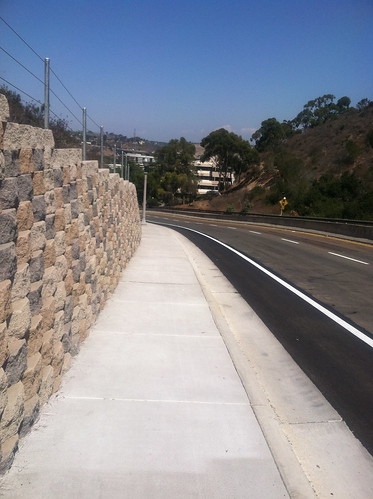
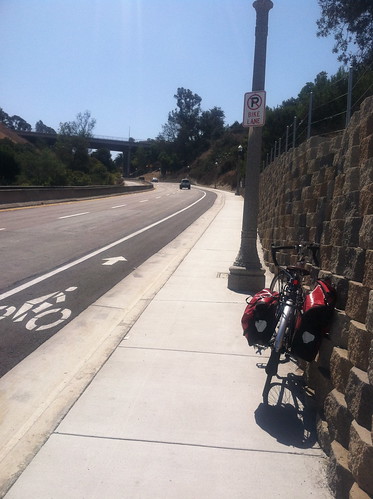
Earlier last month I contacted Penny Gray, the Bicycle Program Manager at Caltrans HQ in Sacramento to ask about what the existing standards were on bike lanes, or what is called "Class II" bikeways. She responded stating (in part),
The Highway Design Manual Section 300 discusses the requirements for Class II Bikeway Lane Widths.
The Highway Design Manual Section 300 (see link below) discusses the requirements for Class II Bikeway Lane Widths.
"(1) General. Class II bikeways (bike lanes), for the preferential use of bicycles, may be established within the roadbed nd shall be located immediately adjacent to a traffic lane as allowed in this manual. Typical Class II bikeway configurations are illustrated in Figure 301.2A. A bikeway located behind on-street parking, physical separation, or barrier within the roadway is not a Class II bikeway (bike lane); see Index 1003.1 Class I Bikeway (Bike Path) for standards and design guidance. The minimum Class II bike lane width shall be 4 feet, except where:
Adjacent to on-street parking, the minimum bike lane should be 5 feet.
Posted speeds are greater than 40 miles per hour, the minimum bike lane
should be 6 feet, or
On highways with concrete curb and gutter, a minimum width of 3 feet
measured from the bike lane stripe to the joint between the shoulder
pavement and the gutter shall be provided.Class II bikeways may be included as part of the shoulder width See Topic
302."While the Streets and Highways Code Section 891 states "All city, county, regional, and other local agencies responsible for the development or operation of bikeways or roadways where bicycle travel is permitted shall utilize all minimum safety design criteria and uniform specifications and symbols for signs, markers, and traffic control devices established pursuant to Section 890.6 and 890.8", many cities and counties use their own standards and designs based on engineering standards, etc. As a result, you may find many bike lanes that do not conform to the state standard.
Since Caltrans is intent on turning all bike riders and advocates into amateur civil engineers, I took a tape measure with me when I rode over to Texas Street to check out the new improvements. The new southbound section of Texas Street measured exactly 4 feet per the existing standards listed in the highway manual and not an inch more. Thankfully, the gutter provides a bit of a buffer from pedestrians who want to walk down into Mission Valley.
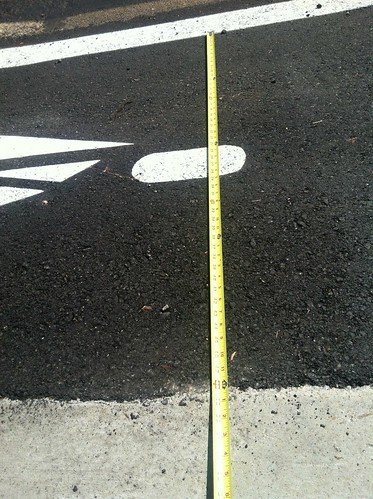
While the progress on Texas Street was ongoing, I had contacted Jake Aquino who works for the Bicycle Program at the City of San Diego to ask about adding a painted buffer to protect bicycle riders from fast moving motor vehicles. Aquino responded stating (in part),
Buffered bike lanes would reduce the effective bike lane from fix feet to four feet with a two feet buffered lane. Also, the proposed two feet gutter would further reduce the effective bike lane from four feet to two feet. Two feet of effective bike lane is undesirable so we cannot recommend the installation of buffered bike lanes at this time
While Aquino only focused on the bike lane width, he should have considered restriping the vehicle lanes in order to transform Texas Street from a speedy thoroughfare to a traffic calmed street. In a 2005 Caltrans publication titled Main Streets: Flexibility in Design and Operations(pdf), I quote an excerpt on reducing lane widths:
Reduced lane widths in combination with other traffic calming measures may encourage slower speeds, which is desirable for a main street. Where existing right of way is limited, reducing lane widths can provide adequate shoulder width for bike lanes and sidewalks.
As San Diegans are more than aware, we have three north/south freeways that connect the mid-city community to the rest of the city: the SR-163, the I-15 and the 805. A speedy thoroughfare (such as freeways) that is designed to reduce conflict with other road users should be promoted to our driving public and surface streets that are known to have other road users should be redesigned to discourage speeding vehicular traffic by implementing traffic calming designs that will be inviting to the the non-driving public and a pleasant (and less noisy) street for the residents.
While the southbound section of Texas Street has been made a little nicer for the bike riding population, the northbound section needs a little bit of maintenance work:
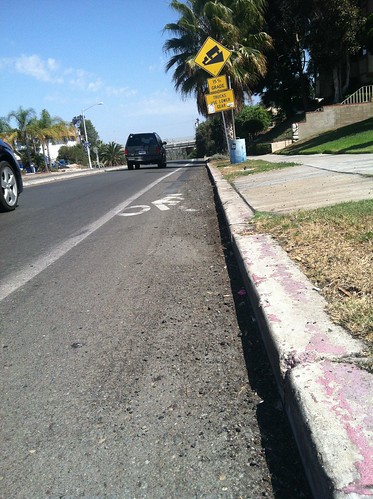
The northbound (downhill) section of Texas Street has a bike lane does a very effective job of collecting road debris and the the bike lane width (including gutter) is less than four feet wide. The city should consider restriping this section of the bike lane on Texas Street and making it a bit more beautiful and inviting than it currently is.
For more photos of Texas Street's bike lanes, see this photo set on flickr.
What are your thoughts about the new southbound bike lane on Texas Street? Would a buffer help?
Photos of Ruffin Road Bike Lanes
Nearly a year ago, we began covering the (then) yet to be striped bike lanes on Ruffin Road - a vital north/south artery for riders who both commute to and live in Kearny Mesa.
I finally had the chance to ride along Ruffin Road to get a sense of what the 3.25 miles of newly striped bike lanes looked and felt like. Riding on Ruffin Road on the bike lane was a more pleasurable experience than riding without the bike lane. The current posted speed limit on Ruffin Road is 45 miles per hour. I'd be curious to know what the 85th percentile speed limit is now with the striping of the bike lanes and whether the presence of the new bike lanes has resulted in slightly slower driving speeds.
The photo below shows the view of Ruffin Road at Aero Drive, including the uphill climb awaiting anyone wishing to head north along Ruffin Road. With a wider sidewalk, a buffer added to the entire length of the Ruffin Road bike lanes - Kearny Mesa could aspire to be a much more friendly to all San Diegans.

The photo below was taken right at the start of the bike lane. With about a quarter of the bike lane in the gutter, riding here was not very enjoyable.

The bike lane improves as one heads further north. There is a bit of clearance between parked cars as seen below thus reducing the possibility of getting doored by an inattentive driver.

I noticed that at intersections, signs were placed to encourage drivers to yield to bicycle riders and the bike lane striping changed from a solid line to dashed lines. Some cities have been experimenting with coloring the bike lanes at potential conflict points(such as intersections). Visually I imagine bright green is more arresting than dashes. But the "Yield to Bikes" sign was very encouraging step forward.

Below was the start of some real change being implemented on Ruffin Road - a bike lane with a buffer to the left of the bike lane which will give the rider a little bit more breathing room when being passed at vehicles traveling at or above 45 miles per hour.

The buffer disappears and the solid line turns into dashes to indicate that an intersection is approaching.

Heading north the buffered component becomes a bit of a head-scratcher. Seems like our bike lane stripers took some artistic liberties in striping this section of the buffered bike lane as seen below.

I'd venture a guess that the goal was to narrow the vehicle lane more than crafty handiwork on the part of our city employees.

The buffer reaches its widest point right before Clairemont Mesa Boulevard as seen below. The bike lane and its buffer now looks as wide as the regular travel lane.


Heading south on Ruffin Road was a different story. There was no buffer to be had, which wasn't a huge issue as road heads south both in direction and in incline. But the big problem was individuals mistaking the bike lane for a parking lane, especially around National University. The University community was parking alongside the curb, despite the presence of ample free parking in lots on the University campus. Since I've noticed drivers paying attention to visual cues (like paint) more than signs, perhaps painting the cub red would drive home the message that the bike lane is not parking lane.

In areas where there were double lines there was no mistaking that the bike lane was not a parking lane.

Closer to Aero Drive, the same problems on the northbound section of the bike lane appeared with part of the bike lane in the gutter. But with the red curb paint and the "No Parking in Bike Lane" signs, the ride down wasn't as unpleasant.

The biggest reason for the delay in taking a look at these bike lanes was my general dislike of riding down Fairmount Avenue or Texas Street in order to get to Kearny Mesa. Both Fairmount Avenue and Texas Street are unpleasant to ride on and Mission Valley is downright terrifying to ride through. While I can avoid riding down Fairmount and through Mission Valley, many San Diegans don't have that choice or cannot make that choice. I hope the city considers improving these areas sooner rather than later so that more San Diegans can benefit the beauty of San Diego outside an automobile without having to fear for their lives.

